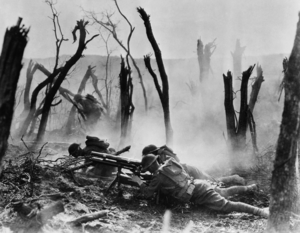Meuse–Argonne offensive facts for kids
Quick facts for kids Meuse–Argonne offensive |
|||||||
|---|---|---|---|---|---|---|---|
| Part of the Western Front of World War I | |||||||
|
An American gun crew from Regimental Headquarters Company, 23d Infantry, firing 37mm gun during an advance against German entrenched positions. |
|||||||
|
|||||||
| Belligerents | |||||||
| Commanders and leaders | |||||||
| Units involved | |||||||
|
|
|||||||
| Strength | |||||||
380 tanks 840 planes 2,780 artillery pieces |
450,000 personnel | ||||||
| Casualties and losses | |||||||
| Total: 192,000 26,277 killed 95,786 wounded |
Total: c. 126,000 28,000 dead 42,000 wounded 26,000 POWs taken by Americans 30,000 POWs taken by French 874 artillery pieces captured by both |
||||||
The Meuse–Argonne offensive (also known as the Meuse River–Argonne Forest offensive, the Battles of the Meuse–Argonne, and the Meuse–Argonne campaign) was a major part of the final Allied offensive of World War I that stretched along the entire Western Front. It was fought from September 26, 1918, until the Armistice of November 11, 1918, a total of 47 days. The Meuse–Argonne offensive was the largest in United States military history, involving 1.2 million American soldiers. It is the second deadliest battle in American history, resulting in over 350,000 casualties including 28,000 German lives, 26,277 American lives and an unknown number of French lives. U.S. losses were worsened by the inexperience of many of the troops, the tactics used during the early phases of the operation and the widespread onset of the global influenza outbreak called the "Spanish Flu".
Meuse–Argonne was the principal engagement of the American Expeditionary Force (AEF) during World War I. It was one of a series of Allied attacks known as the Hundred Days Offensive, which brought the war to an end. It was the largest and bloodiest operation of World War I for the AEF even if, given the scale of other battles on the Western Front, its size was limited and the operation itself secondary as it was far from the main offensive axis.
Images for kids
-
General John J. Pershing, Commander-in-Chief of the American Expeditionary Forces (AEF).
-
Lieutenant General Hunter Liggett, commanding the U.S. First Army.
-
Lieutenant General Robert Lee Bullard, commanding the U.S. Second Army.
-
U.S. Marines during the offensive
-
Two-seat German Hannover biplane forced down near Cierges
See also
 In Spanish: Ofensiva de Meuse-Argonne para niños
In Spanish: Ofensiva de Meuse-Argonne para niños










